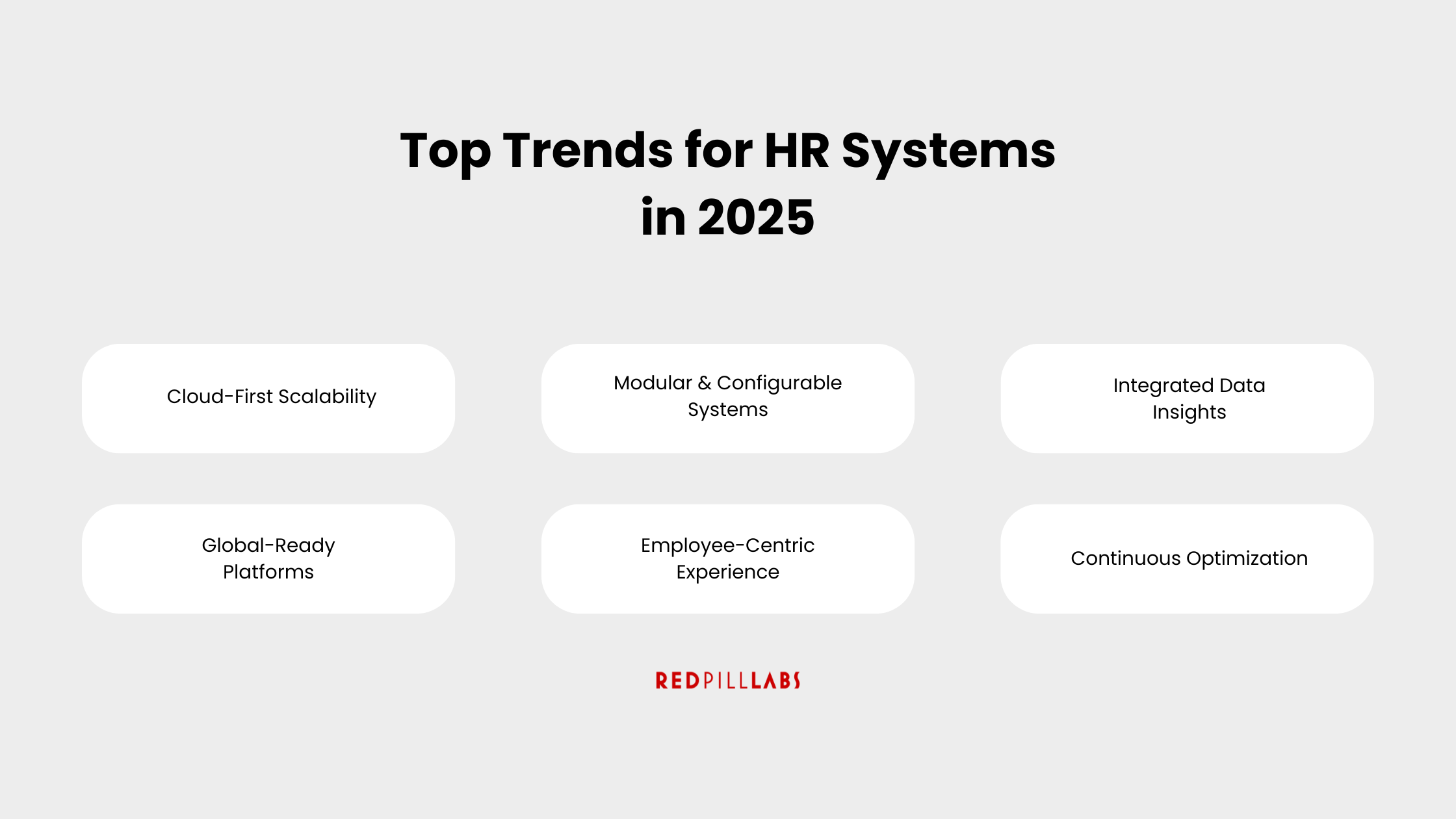Top 6 HR System Trends in 2025
blog/top-6-hr-system-trends-in-2025
2025-07-17
In 2025, scalability is a essential for supporting an agile workforce and maintaining operational efficiency.
A scalable HCM/HRIS platform can accommodate growth, adapt to changing workforce needs, and integrate with other systems without sacrificing performance or data integrity.
This urgency is reflected in industry data: according to Gartner, 60% of midsize and large enterprises plan to invest in cloud HCM solutions to support workforce agility and scalability by 2026, underscoring the growing demand for modern, flexible HR technology.¹
Similarly, Deloitte reports that 74% of HR leaders believe technology modernization is essential to enabling growth and innovation.²
With these priorities in mind, here are the top trends shaping HCM and HRIS in 2025:
Top Trends for HR Systems in 2025
1. Cloud-First, Scalable Platforms Become Standard
Organizations are leaving behind on-premise systems in favor of cloud-based platforms that can scale as their workforce grows.
The flexibility of cloud deployment allows companies to quickly add new employees, regions, or modules without major infrastructure changes.
PwC’s 2024 HR Technology Survey found that 73% of cloud HCM adopters reported improved scalability and lower total cost of ownership compared to on-premise systems.³
2. Modularity and Configurability Drive Adoption
In 2025, one-size-fits-all is out.
Organizations are gravitating toward platforms that offer modular functionality — adding only what they need, when they need it — and high configurability to adjust workflows, rules, and interfaces without costly customization.
This trend enables HR teams to respond faster to organizational changes and regulatory shifts.
3. Data Integration Powers Strategic Insights
Integrated systems are no longer optional.
As more HR departments seek to deliver workforce analytics and predictive insights, seamless integration between the HRIS and other business systems (like payroll, benefits, and learning management) is critical.
According to Sapient Insights Group, companies with strong HR technology integration are 33% more likely to deliver strategic HR insights and 36% more likely to report improved employee experience.⁴
4. Global Readiness Supports Expansion
With more businesses expanding internationally, HRIS platforms that support multiple currencies, languages, and local compliance requirements are in high demand.
In fact, a KPMG survey found that 68% of HR leaders at multinational firms cited lack of global HRIS scalability as a barrier to entering new markets.⁵
Expect to see more organizations prioritizing global-readiness features in their 2025 technology investments.
5. Employee Experience at the Center
Ease of use, mobile access, and self-service are no longer perks — they are baseline expectations.
Scalable systems must not only support more users but also maintain an intuitive experience.
HR teams are also investing more in training and change management to ensure employees and managers can effectively use the tools.
6. Continuous Optimization and Governance
The final trend is not purely technical but organizational: treating HR technology as a continuously evolving platform.
Regular audits, performance monitoring, and user feedback help ensure systems remain aligned with business needs, even as those needs change.
Why These Trends Matter
As Deloitte’s 2024 Human Capital Trends report puts it:
“Organizations that modernize their HR technology for scalability are 1.4 times more likely to exceed their financial performance goals.”²
Organizations that embrace these trends — prioritizing scalability, integration, employee experience, and global readiness — will be better positioned to meet the demands of a competitive and fast-changing workforce landscape.
Sources:
Gartner, “Market Guide for HCM Suites,” 2023.
Deloitte, 2024 Human Capital Trends Report.
PwC, HR Technology Survey 2024.
Sapient Insights Group, 2023-2024 HR Systems Survey.
KPMG, Global HR Technology Survey, 2023.


